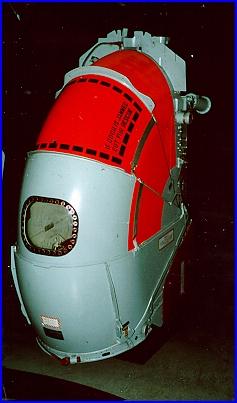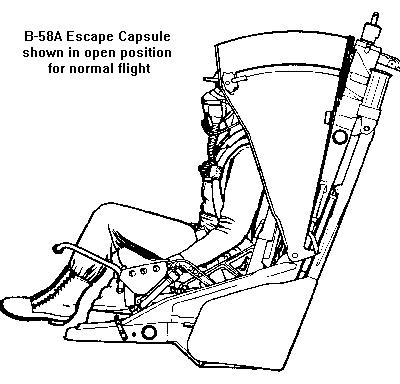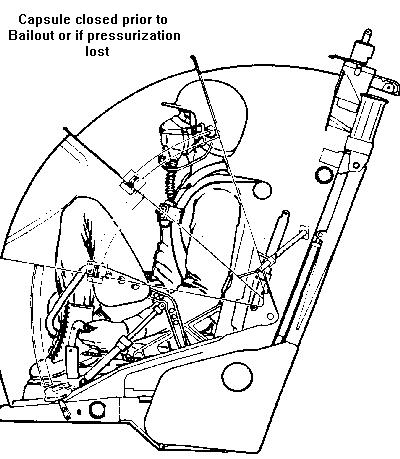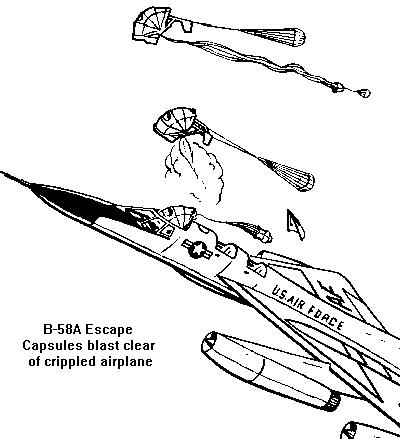
America's first supersonic bomber, the B-58A Hustler built by Convair in Fort Worth, Texas, posed just this problem for the three-man crews that flew her. Early production and test airplanes were equipped with conventional upward ejection seats, one for each of the tandem seated crew members.
Side-mounted headrest panels helped hold the crewman's head steady so windblasts would not toss the head about too wildly. Straps attached to hands and feet automatically tighened on ejection to minimize arm and leg flailing. Those measures helped, but were not really much protection at Mach 2. More was needed.

The solution to the problem came from Stanley Aviation Company of Denver, Colorado. Stanley and Convair developed the fully enclosed crew capsule, a folding egg-shell-like system to replace conventional ejection seats. All B-58's ( except the two-pilot TB-58 models used to train and evaluate pilots ) were eventually upgraded with capsules.
The capsules greatly improved both crew safety and comfort. During normal flight the capsule remained open, permitting crew members access to their equipment. Lap, chest and shoulder straps to restrain crewmen during flight were built right into the capsule. It was quite roomy, except for very large men. Those with size 12 or larger boots were at risk of losing their toes on capsule closure.

Two occasions typically called for enclosing the capsule. In flight the capsule provided a moderately safe caccoon when cabin pressure failed or smoke filled the cockpit, including oxygen mask hookup. The vacuum tube avionics system was prone to overheating and putting smoke and fumes into the cockpit.
Safe ejection could be expected throughout a wide range of airspeed and altitude conditions. The accompanying chart depicts that capsule performance envelope. Only extremely high speeds posed ejection risk, or very low speeds at low altitudes. The system was not a zero-zero one permitting safe ejection on the runway.
The primary reason for capsule closure was bailout. The capsule snapped shut quickly when the trigger handles were activated by crewmen. Each independently controlled his own capsule. The closure sequence included automatic restraint and positioning of the user. Shoulder straps tightened and pulled the crewmen back. A bar passing laterally under the legs raised the knees and then pulled heels back against the seat pan. An upright fetal position was needed to assure capsule door clearance.

The pilot's capsule featured a window large enough to permit seeing most of the forward instrument panel. The flight control stick also fitted within the capsule, enabling limited control of the plane. The stick-mounted trim buttons and other switches afforded some, though not full, control. The other two crewmen had smaller windows which did not present much useful visibility in the cockpit.
A capsule closed in flight could be opened, with some difficulty, if flight was continued and bailout not imminent. Doors could be unlatched with levers located near your toes. Reaching those latches was not easy.
Squeezing the ejection trigger handles caused the overhead canopy to separate from the plane, followed quickly by the rocket-fired upward blasted capsule. As soon as the capsule cleared the airplane a drogue stabilizing parachute kept the system oriented properly. The main parachute deployed automatically at the appropriate altitude on descent.Normal landing attitude placed the crewman on his back at impact. That helped distibute the shock.

The pilots was normally the last to leave. A rear to front sequence was recommended, under a controlled bailout situation. That would preclude possible interference of one ejecting capsule to another. In very hasty bailout situations, such as might occur immediately after takeoff, crewmen left as fast as they could.
Crew comfort, especially for the Navigator and Defensive Systems Operator, was very good. Indirect lighting afforded good working conditions at charts or reference manuals. Though not overly generous, a worktable for each was far better than a mere clipboard.
Only two short-comings made long flights a chore. There was no way one could stand up and stretch. There simply wasn't room. And there was no toilet. Only a one-quart bottle could be used for bladder emptying. If you had to defecate, tough luck. There was no way or place. And, there was no movement between cockpits. Only a pouch on a clothesline permitted passing notes or documents from one cockpit to another. This page is courtesy Phil Rowe, the author of an excellent aviation site featuring the B-58 Hustler.